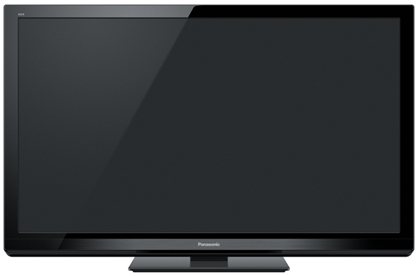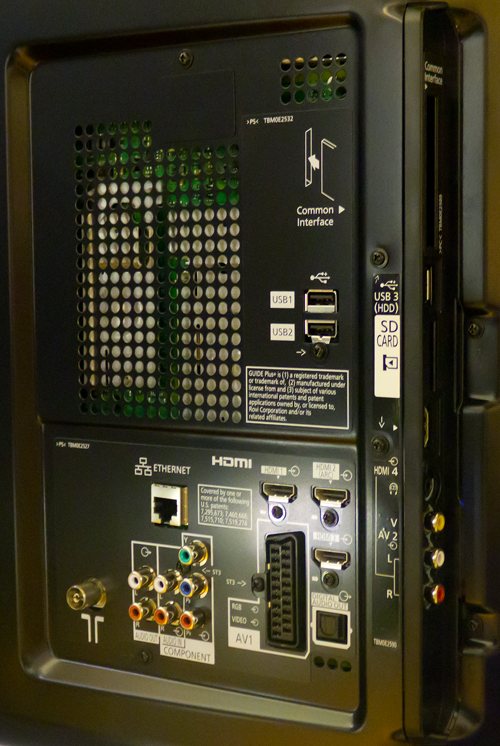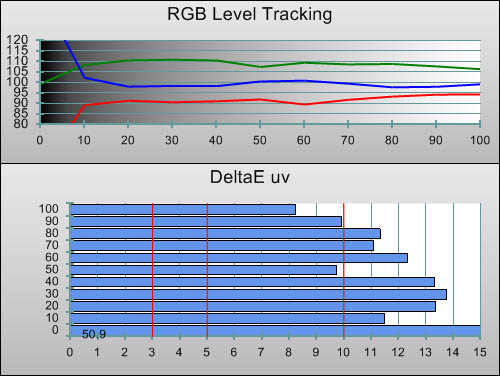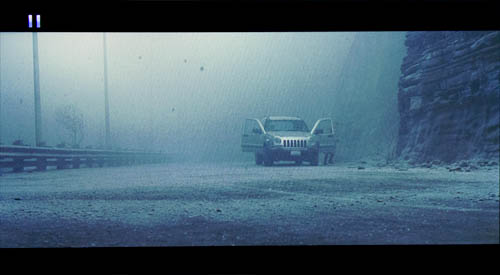Last year’s Panasonic G20 series emerged from 2010 as the Plasma HDTVs to beat at the mid-range price point. 2011’s midrange model, the new TX-P42G30B, has been with us for the last few weeks for in-depth calibration and assessment. As it happens, the Viera G30 is actually the most advanced 2D-only Plasma TV that Panasonic is selling this year: if you want additional features like “Infinite Black Pro” (the most compelling feature of which is a screen filter which provides better contrast performance in rooms with ambient light present), a Freesat satellite tuner, and of course, 3D, then you’ll need to look at the GT30 series instead.
<!-- google_ad_client = 'pub-2887677957235196'; google_ad_slot = '4990177225'; google_ad_width = 336; google_ad_height = 280; //-->
However, if the Panasonic TX-P42G30B’s terrestrial (Freeview HD) tuner, 4 HDMI inputs, and network connectivity are enough to meet your needs, then read on to find out just how this midrange NeoPlasma performs.
Note: The specific review unit we tested was the Panasonic TX-P42G30B which is the British 3-pin-plug version. The same plasma may be sold by retailers like Comet, Currys and John Lewis, and etailers such as Amazon and Dixons as the Panasonic TX-P42G30 or TXP42G30. Throughout this article, these model numbers may be used interchangeably to refer to the same HDTV.
While we did not review larger G30 models (e.g. the 50-inch TX-P50G30B), there should not be any significant difference in picture performance given similar specifications.
Jump To: Operation • Calibration • Picture Performance • Conclusion
The Panasonic TX-P42G30 lands in our review room at a convenient time: directly after the Panasonic GT30, allowing for tests to be done with the 3D-capable variant model fresh in our minds. In 2010, the 3D-capable Plasmas (which have “T” in their model number) were very similar in specification and looks to the 2D-only variants. This year, however, the 2D-only equivalent model looks noticeably less slick when compared to the styling of the 3D-ready GT30. For a start, there is no brushed steel finish surrounding the panel; 3D refuseniks are instead treated to standard gloss black. The TXP42G30 is still fairly thin, measuring at about 5cm deep (there’s a slight bulge at the bottom, to house the speakers).

With that said, the TX-P42G30B still looks slick enough, and is definitely a step up design-wise from 2010’s G20 model. Build quality is excellent, as usual for Panasonic Plasmas. Other than a small gap between the casing and the side-panel buttons, we had no complaints with this sturdy display.
The Panasonic TX-P42G30B features the now-standard 4 HDMI inputs, the mandatory analogue Component input, a single RGB SCART terminal for interfacing with older Standard Def devices, and a Composite video jack, which offers the lowest quality input and should be avoided at all costs, unless you, for whatever reason, happen to be using a Composite video source, such as a VHS VCR or a LaserDisc player (anyone?). Moving back into modern times, there are also 3 USB ports, an SD Card slot, a Digital TV Common Interface card slot, and an Ethernet connection for hooking the panel up to the wider world.
Unlike last year’s G20 model, there is no second SCART terminal and no analogue RGBHV (PC) input. We doubt these will be missed by many users, but tell us in the Comments if you disagree. Sadly, on the TX-P42G30B, there is no satellite tuner this year – for that, you’ll need to step up to the TX-P42GT30B.
 |
| Rear: 4 x HDMI, Component, SCART, aerial, ethernet & audio outs |
The Panasonic TX-P42G30 features the same newly designed menus that we spotted on the TX-P42GT30. They’re more aesthetically pleasing than last year’s, and are also more logically structured: for example, the [Setup] category no longer features any picture adjustments – they’re all in the [Picture] area now. Users who want access to the White Balance, Colour Management and Gamma controls do still have to enable the “advance(isfccc)” option in the [Setup] screen first, though.
![[Picture] menu](https://www.hdtvtest.co.uk/news/wp-content/uploads/2018/04/hdtv_Panasonic-TXP42G30_picturemenu.jpg) |
![[Picture] menu](https://www.hdtvtest.co.uk/news/wp-content/uploads/2018/04/hdtv_Panasonic-TXP42GT30_picture2.jpg) |
| [Picture] menus |
The picture modes that we’re most interested in are the [THX] mode and the two [Professional] options, since these produce the most accurate, true-to-spec pictures. Unfortunately, the [White Balance], [Gamma] and [Colour Management] controls do not appear in the [THX] mode. This is a step backwards from Panasonic’s 2010 displays, where the White Balance menu was at least functional. Although the point of the [THX] mode is to come as close as possible to industry standards without requiring calibration, every individual Plasma screen is different, meaning that some fine-tuning is still sometimes a good idea. Hopefully Panasonic can reinstate this menu with firmware, or at least keep this in mind for the future, because as we’ll discuss later in the review, the [THX] mode has some unique characteristics which make calibrating it desirable.
Note: Our Panasonic TX-P42G30B review sample was calibrated using Calman Professional, the industry-leading video calibration software.
We let our brand new Panasonic TXP42G30 review unit age for a good number of hours, and then ran the following measurements using the small APL windows from the AVSHD test disc. We ran the pre-calibration measurements in the [THX] picture mode to see how well the 42G30 was fulfilling its intended purpose of offering accurate image quality without the need for individual calibration attention.
 |
| Pre-calibration RGB tracking and delta errors (dEs) |
Like the GT30 we reviewed recently, the THX picture mode on the Panasonic TX-P42G30B produced an image that was somewhat green-tinted. Although there’s little hard data on this phenomenon, we do know that the Greyscale characteristics of a Plasma television will shift as the panel ages. With that in mind, we wonder if the THX mode has been optimised for the middle (rather than the beginning) of the TV’s life – perhaps the green tint would disappear with usage (it’s a shame we can’t measure a 200 or 500-hour old TX-P42G30 to test that theory). In any case, the image quality did appear somewhat tinted to our eyes on our new review sample, but do keep in mind that we’re used to looking at HDTV displays which have been calibrated within an inch of their lives. On the up-side, the Greyscale tracking was incredibly linear, meaning that the green tint to the picture was consistent from the lightest to the darkest shades, and therefore easier to ignore.
![Post-calibration RGB Tracking in [Professional1] mode](https://www.hdtvtest.co.uk/news/wp-content/uploads/2018/04/hdtv_Panasonic-TXP42G30_post-rgb.jpg) |
| Post-calibration RGB tracking and dEs in [Professional1] mode |
Equalising Greyscale mixing on the TX-P42G30B was almost effortless. After a short amount of time measuring the output of the plasma and adjusting the [White Balance] controls to offset the tint, familiar, bias-free “video white” slipped into view. The results here were comparable to both the GT30 and last year’s G20, with there being no obvious tints left in the image, except for a very, very mildly discoloured 10% stimulus measurement.
![Gamma curve in [Professional1] mode](https://www.hdtvtest.co.uk/news/wp-content/uploads/2018/04/hdtv_Panasonic-TXP42G30_post-gamma.jpg) | |
| Gamma curve in [Professional1] mode | Corresponding gamma tracking |
On a TV display, “Gamma” describes the output luminance relative to the input video signal – in other words, whether or not the amount of light being put out by the television at each brightness level is correct. Getting entirely consistent, flat Gamma tracking has never been easy on any of the consumer Plasma TVs we’ve reviewed (with one exception – the legendary, now out-of-production Pioneer Kuro PDP-LX5090). Measuring with different sized windows alters the measurements to some degree (due to the Plasma display’s Automatic Brightness Limiting circuit), indicating unpredictability with real-world material. With this in mind, we measured using the small APL (Average Picture Level) window patterns from the AVSHD test disc. In these conditions, the Panasonic TX-P42G30 rose out of black slightly too quickly and revealed a touch too much shadow detail, but we still measured an average gamma of 2.1.
We also tried manipulating the low-end [White Balance] controls in the user menu simultaneously in an effort to reduce errors, and also experimented with the ALL-CUT and ALL-DRV controls in service mode. In these cases, we found that we could make small improvements to Gamma, but at the expense of Greyscale tracking. In other words, any attempts to get perfect Gamma tracking resulted in overly red-tinged shadows, and neutralising this would bring us back to where we started. We could never get flawless results from both simultaneously, although we think our readers will agree that Gamma errors are the lesser of many possible evils.
Colour reproduction was excellent on Panasonic’s 2010 HDTVs, despite their limited Colour Management controls. With this year’s G30 model, the [THX] mode produced excellent colour straight out of the box, with only minor errors (green was slightly oversaturated, and red was pushed slightly more towards orange) being measured.
Using the control over primary colours provided in the [Professional] modes on the TX-P42G30B, we adjusted the Hue and Saturation for Red, Green and Blue, in order to gain the following result. As you can see, the secondary colours inbetween were very close to ideal accuracy, even although no control is given over them.
![Post-calibration CIE chart in [Professional1] mode](https://www.hdtvtest.co.uk/news/wp-content/uploads/2018/04/hdtv_Panasonic-TXP42G30_post-cie.jpg) |
| Post-calibration CIE chart with reference to HD Rec.709 |
We also made minor adjustments to the [R-Luminance], [B-Luminance] and [G-Luminance] controls (new for 2011) to further fine-tune the brightness of each colour on the Panasonic TXP42G30. As with the Hue and Saturation, no control is given over the Luminance of the secondary colours, but the remaining errors are very small:
![Post-calibration Luminance levels in [Professional1] mode](https://www.hdtvtest.co.uk/news/wp-content/uploads/2018/04/hdtv_Panasonic-TXP42G30_post-colour-lum.jpg) |
| Post-calibration colour luminance (coloured bars = targets; black bars = measured values) |
| Dead pixels | None |
| Screen uniformity | Perfect |
| Overscanning on HDMI | 0% with [16:9 Overscan] set to “Off“ |
| Blacker than black | Passed |
| Calibrated black level (black screen) | 0.02 cd/m2 |
| Calibrated black level (ANSI checkerboard) | 0.02 cd/m2 |
| Black level retention | Stable in [THX] and [Photo], some shifting otherwise |
| Primary chromaticity | Excellent |
| Scaling | Excellent |
| Video mode deinterlacing | Very effective jaggies reduction |
| Film mode deinterlacing | Passed 2-2 PAL and 3-2 NTSC tests in SD and HD |
| Viewing angle | Excellent |
| Motion resolution | 1080, but with noisy edges unless [Intelligent Frame Creation] used |
| Digital noise reduction | Present, defeatable |
| Sharpness | Defeatable edge enhancement |
| Luma/Chroma bandwidth (2D Blu-ray) | Full Luma, Full Chroma |
| Image retention | Very little |
| Posterization | Mild, though worse with poor source |
| Phosphor trails | Very mild |
| 1080p/24 capability | No judder |
| Input lag | 24ms compared to lag-free CRT |
| Full 4:4:4 reproduction (PC) | No, 4:4:4 input subsampled |
| [THX] mode | 164 watts |
| Calibrated [Professional1] mode | 136 watts |
| Standby | 1 watt |
Note: Measurements taken with full 50% grey screen.
We weren’t surprised at all to see the Panasonic TX-P42G30B’s minimum luminance level – that is, the deepest black it was capable of producing – measure at 0.02 cd/m2. This is exactly the same measurement we received from the equivalent 2010 model, the G20, which would make sense given that both plasma televisions are (were) promoted under the “Infinite Black” banner. A measurement as low as 0.02 cd/m2 indicates that the TX-P42G30 can produce a satisfying, deep shade of black, although it’s bettered by higher-end Panasonic Plasmas, and of course, the final generation of the Pioneer Kuro plasma displays (although pitting an £800 display against the discontinued Pioneer Kuro Plasmas is a fairly pointless comparison).
But what about ANSI contrast performance? We were curious to see if the TXP42G30 could match the impressive mixed-scene contrast that we saw on the 3D-capable GT30 (which carries the “Infinite Black Pro” branding, rather than the G30’s “Infinite Black”). The answer is yes, it can – the improvements here are not limited to the “Infinite Black Pro” displays. With our Klein K-10 pushed directly against the screen (as it always is during our calibration process), the same 0.02 cd/m2 measurement was returned from the black patch in the chart. We’re not sure what Panasonic has done to bring mixed-scene contrast performance up to this level, but it’s impressive to say the least. In side-by-side comparisons with last year’s G20, the improvement here was particularly noticeable with letterbox bars on 2.35:1 ratio films – the bars on the G30 stayed pitch black.
Unfortunately, the TX-P42G30B shows the exact same “brightness shifting” issue that we noticed with the GT30: with certain video content, the Plasma TV will appear to adjust gamma mid-way through a scene. Although we feel the effect is subtle, it does occur fairly frequently. Name any predominantly dark film you can think of, and odds are, eagle-eyed viewers will notice some shifting going on as they watch. In our GT30 review, we mentioned scenes from Se7en as revealing the issue, but we also noticed it during the newer, director-approved Blu-ray Disc of Silent Hill. In the latter example, there’s a scene early on in the film where a character runs out into a highway, only to narrowly avoid being hit by a truck. As soon as the truck appeared in shot, the TX-P42G30’s gamma characteristics would change, giving the scene a lighter look.
As with the GT30, we could not reproduce the issue in [THX] mode, which gave us stable brightness during our testing. However, the THX mode (while good for an uncalibrated preset) doesn’t offer any of the calibration options that the [Professional] modes do, which meant that Greyscale was slightly green-tinted, and Gamma was slightly too low, resulting in a less punchy image than would be ideal (on our individual review unit, at the time of measurement). We also experimented with other modes and found that the [Photo] mode was free of these brightness changes, but interestingly, uses a slightly rougher, noisier-looking panel drive mode with slightly more false contouring artefacts appearing during motion. This would make sense, since we’d imagine motion rendering was not the prime concern for a mode designed for displaying still images.
With this in mind, we attempted to calibrate the [THX] mode’s Greyscale by entering the TXP42G30’s service menu and adjusting the RGB-DRV and RGB-CUT controls. This is a potentially dangerous process (there are options in here which can turn your TV into a 42-inch paperweight if accidentally altered). We successfully calibrated Greyscale with this method, but couldn’t do anything about the THX mode’s lower gamma setting, which left images looking very slightly less punchy than we’d have liked. Again, this observation is based on comparisons of many, many high-definition televisions, and most users will have nothing to complain about. However, this situation means that each of the [Viewing Mode] options on the Panasonic TX-P42G30B has its own strengths and weaknesses which readers will want to know about. We measured every usable mode (disqualifying any which performed obvious dynamic contrast adjustments to the image, or those which enforced a non-standard colour gamut) and came to this list of the following choices:
This is the second 2011 Panasonic Plasma that’s exhibited this behaviour. As usual, we have to be wary of writing essay length notes about a small problem, but we know that there are users out there who’ll consider this a deal-breaker. The fact that certain Viewing Modes are free of the problem makes us wonder if there’s any good reason why the [Professional] modes shouldn’t also be capable of showing stable brightness, but since we’re not Plasma TV engineers, we can only speculate. Although the brightness changes are subtle, especially compared to the auto-dimming shown by some LCD TVs, we do hope that Panasonic can iron this out with a firmware update.
Using the time-honoured motion resolution test chart on the FPD Benchmark Software test disc, we gauged the TX-P42G30B’s motion resolution at around 1080 lines. This result is a small improvement on the 900 lines measured from last year’s TX-P42G20. Although the Viera G20 plasma could technically resolve all 1080 lines, it required the Intelligent Frame Creation system to be turned on, and the resulting motion interpolation glitches didn’t really justify the imperceptible difference in clarity with real-world material. The reason for this year’s slight performance improvement is down to the fact that the Panasonic TX-P42G30 is using the new “Short-stroke Phosphor” material, previously reserved for the company’s plasma 3D TV sets. This new, faster-decaying phosphor material results in less of the green and blue streaks (“phosphor trails”) that can be witnessed when Plasma TVs display certain fast-moving objects.
Although the motion resolution of Plasma screens has always been high, they are not free of motion artefacts. In other words, although they can show all 1080 lines of resolution from a synthetic test pattern, motion will not necessarily appear perfect during real-world material. Specifically, eagle-eyed viewers can expect to see some noisiness around contrasted edges during fast-paced camera pans, as well as some coloured posterisation. We noticed this effect with both 50hz and 60hz high-motion (video camera) material. 24fps movies (low-motion content) do not have a high enough frame rate to really highlight any motion artefacts.
Unsurprisingly, 50hz (European) and 60hz (American/Japanese) sources both play back with slightly different motion characteristics. 60hz material is output by the panel at a refresh rate of 60hz, since this is generally high enough for (most) viewers to not notice flickering. On the other hand, 50hz video signals are output by the TX-P42G30B at a doubled refresh rate of 100hz, presumably to avoid flicker. Some users have complained that this causes a double-image effect during particularly fast camera movements from high-motion 50hz material. If the same 50hz frame is drawn twice in one single 100hz panel update, this would make logical sense, but we don’t feel that it’s a deal-breaker.
With high-motion video material, we did sometimes spot coloured “ridges” appearing during camera pans. These were unsightly, and also difficult to predict (certain tones and colours cause the Plasma television to produce motion artefacts, whereas others did not). The [Intelligent Frame Creation] system does result in slightly cleaner motion rendering (it reduces artefacts related to the panel’s sub-field driving but introduces new motion interpolation artefacts, like you’d see on a “200hz” LCD TV). On its “Mid” setting (which is the lowest of the two enabled options), the NeoPlasma panel will refresh at a multiple of the input refresh rate, avoiding judder – so 50hz TV signals are still output at 100hz with the IFC system set to “Mid”. The “Max” setting forces the panel to refresh at 60hz, which introduced some slight judder into fast camera movements. In any case, the [Intelligent Frame Creation] system is only really useful for high-motion video content: we always disabled it during film material to avoid the sped-up “soap-opera look”. Panasonic have been very vocal about the Intelligent Frame Creation technology over the last few years, but we hope they are not only concentrating on improving motion quality via this method. Most enthusiast users, many of whom will gravitate towards Plasma display technology due to its motion clarity potential, will want to use the HDTV with such “bells and whistles” disabled.
The Panasonic TX-P42G30B performed well with standard-def video content. Video mode deinterlacing was excellent, and scaling was crisp and clean. For film content, enabling the [Clear Cinema] option allowed the 2-2 PAL and 3-2 NTSC film mode deinterlacing tests from the HQV Benchmark test discs to pass – in other words, to display film-originated content with full vertical resolution and no added jaggedness. However, real-world playback of the notoriously difficult 2-2 PAL cadence was less predictable and we did sometimes detect the 42G30 dropping back into Video deinterlacing mode during PAL film transfers, showing jaggies. As with the TX-P42GT30, pictures from the internal TV tuner displayed with some very, very subtle additional jaggedness, but this won’t be noticeable from most viewing distances.

This largely trouble-free processing, coupled with the Plasma’s excellent Greyscale and Colour performance, meant that SD material looked as good as we could expect it to on the TX-P42G30B.
We spent a good amount of time critically watching some of our current favourite Blu-ray Disc materal on the TX-P42G30B, in both day and night conditions. During the day – that is, with some ambient light present – the image still had a good amount of contrast, allowing images to look sufficiently deep and involving. However, if viewing in particularly bright environments is a concern, we’d recommend LCD TV technology instead, since its screen illumination method can pump out enough light to compensate for mother nature’s rays.

During night time viewing, the differences between the Panasonic G30 and the higher-specced GT30 became essentially insignificant, and we had no complaints at all. 24p material from Blu-ray Disc was reproduced clearly, without judder, and with full picture detail, without any unwanted revisionism. Image quality was very good (albeit subtly green-tinted) prior to calibration, but after the full treatment, the saturated reds in the caves from The Descent looked more vivid and deep. Similarly, during Silent Hill‘s opening scenes, the [THX] mode’s Gamma characteristics revealed a slight excess of shadow detail, diluting the impact of the dark surroundings a little. Areas of the frame which would ideally appear as being just above black were shown instead as dark grey with small tinges of red or green. Our calibrated [Professional] modes avoided this, and served as a reminder that, as excellent as the [THX] mode is, preset picture modes can only take you so far.

One other thing to note, relating to actual Digital TV broadcasting: during the review process, we did notice a quirk which resulted in the audio volume of Freeview HD channels sometimes suddenly jumping upwards, until we unselected and reselected the channel we were watching. We shared our findings with Panasonic, but at this time of writing, we’re unsure whether or not this issue is confined to our individual unit or local TV transmitter.
Update (21 April 2011): Once we notified them of our findings, Panasonic quickly resolved an issue we found relating to audio on Freeview HD channels with a firmware update. Owners experiencing a sudden jump in sound volume when viewing these channels should connect their G30 to the internet, enter the Setup menu, choose “System Menu”, then “System Update” to rectify the issue – or contact Panasonic for information about a firmware upgrade.
Compared to a lag-free CRT monitor, the Panasonic TX-P42G30 lagged by only around 24ms in the [Game] picture mode, and indeed, the TXP42G30 provided a highly responsive gaming experience with almost no delay inbetween the user and the game world on screen.
Truth be told, after witnessing the GT30 with its Infinite Black Pro screen coating, stepping back down to the Panasonic TX-P42G30’s less light-resistant screen meant that we weren’t as immediately taken by it. Unless you watch TV in total darkness (in which case the differences between the Viera G30 and the 2D performance of the GT30 will be all but invisible), we’d suggest that prospective TX-P42G30B or TX-P50G30B buyers consider stepping up to the GT30, whether they are interested in 3D capabilities or not. Its Infinite Black Pro screen coating does afford the picture a certain depth and glossiness that the G30 can’t fully replicate. Is this, and the fact that the GT30 is also capable of 3D display, worth an extra £300-400, though? We’ll leave that for you to decide.
Back to the matter at hand, though: there are a few small quirks to anticipate with the TX-P42G30B, but after making readers aware of these, we still feel that a rating of “Highly Recommended” is just appropriate given the HDTV’s price of around £850 (although the brightness shifting and lack of calibration controls in the [THX] mode did make us consider dropping the rating down a notch). In the end, we simply can’t think of a more recommendable display at this price point – nothing else produces the same combination of deep blacks, freedom from viewing angle restrictions, and freedom from screen uniformity problems that Panasonic’s Plasma technology provides. Combined with its strengths of excellent Greyscale and Colour accuracy, we can’t imagine many users finding fault with the price-to-performance ratio on offer.

<!-- google_ad_client = 'pub-2887677957235196'; google_ad_slot = '0693194791'; google_ad_width = 336; google_ad_height = 280; //-->